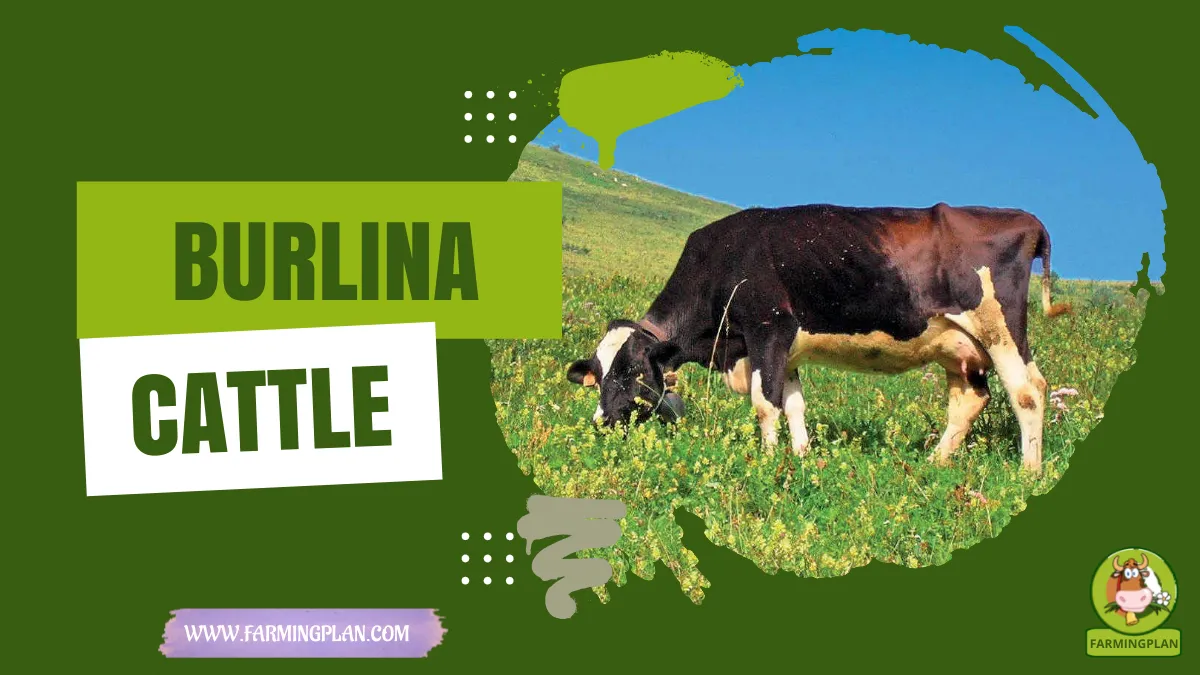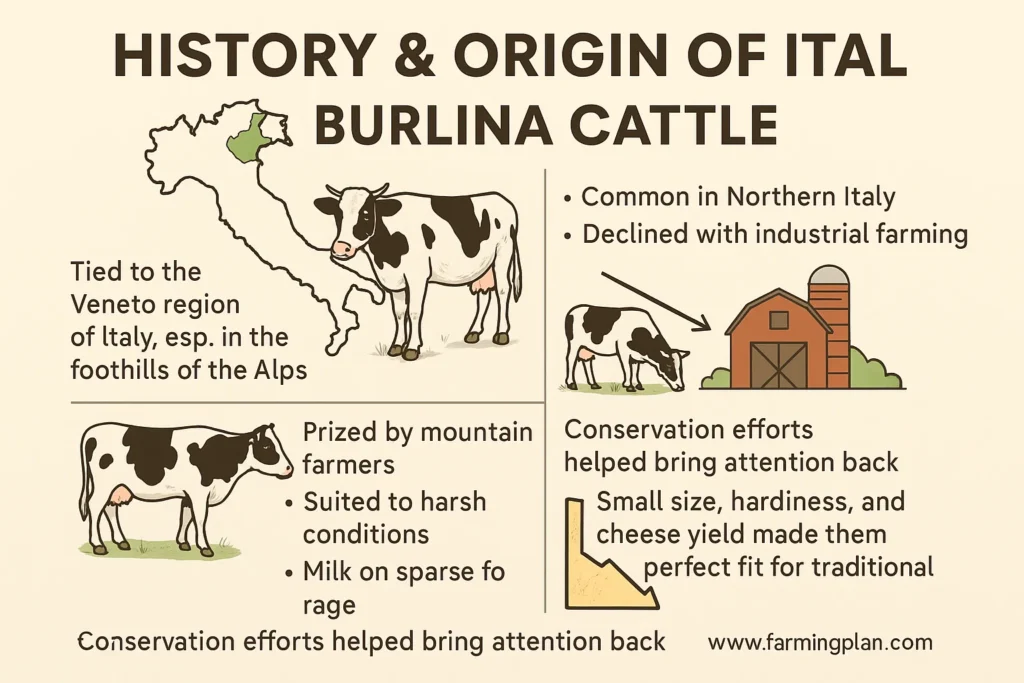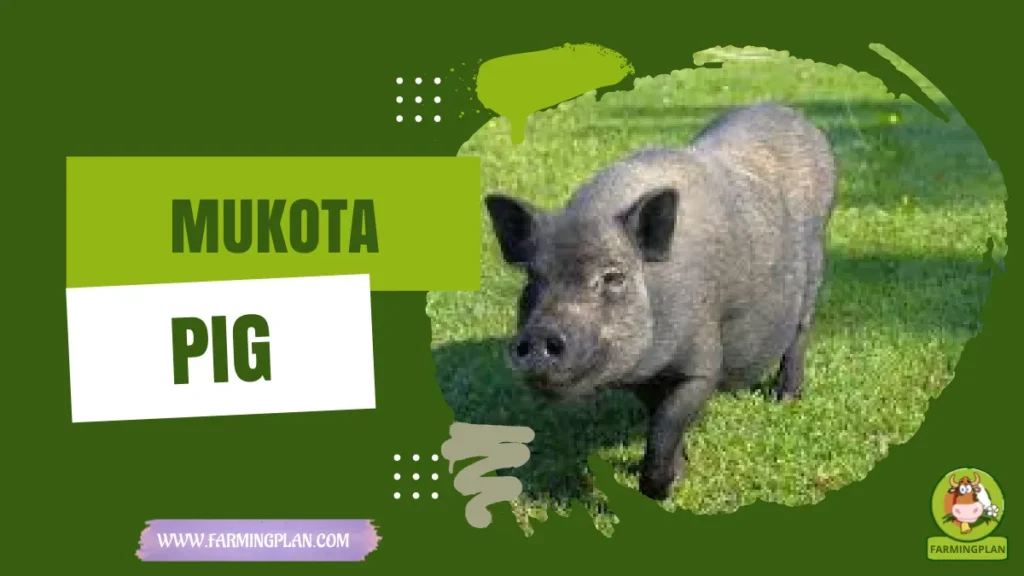When I first started working with native cattle breeds, I was fascinated by the Burlina Cattle. They’re not just another dairy cow—they’re a symbol of resilience and rich milk quality. Originating in the mountainous regions of Northern Italy, Burlina cattle are small, tough, and efficient. Their milk is ideal for cheese-making, packed with abundant casein fractions, high protein composition, and balanced milk minerals. They’ve also got a deep genetic history, offering insight into genomic diversity and effective population size for local breeds. This article is for folks like you—whether you’re a farmer, breeder, animal lover, or even a small-scale cheesemaker looking to learn more about these amazing animals. Let’s dive into their history, care, health, and everything!

History & Origin
Burlina Cattle have a long, fascinating history tied to the Veneto region of Italy, especially in the foothills of the Alps. They’re among the oldest known autochthonous cattle breeds in Europe. Historically, mountain farmers prized them for their ability to survive harsh conditions and produce milk on sparse forage.

Burlina cows were once very common in Northern Italy, especially before the rise of industrial farming. However, with the introduction of high-yield foreign breeds like the Friesian and Brown Swiss, their numbers declined rapidly. Luckily, conservation efforts over the last few decades helped bring attention back to this native breed. Their small size, hardiness, and the cheese yield from their milk made them a perfect fit for traditional dairying, especially for specialty cheeses like Morlacco and Bastardo del Grappa.
Read More: Merino Sheep: Ultimate Wool Breed for Elite Farmers
Characteristics
One of the most striking features of Burlina cattle is their unique appearance. They are medium-small, with black-and-white patches similar to Holsteins but with more irregular markings. Their slender frame conceals an efficient metabolic engine—they convert rough forage into high-quality milk, making them ideal for low-input farms.
These cows are lightweight and agile, a great advantage in hilly or rocky terrain. Despite their smaller stature, Burlinas have a strong bone structure and robust hooves, which means fewer lameness issues. They mature early, calve easily, and have a longer productive life than many commercial breeds. Their milk has a considerable casein content, especially kappa-casein, which is crucial for good milk coagulation properties and cheese production.
Nature & Temperament
One of the most endearing qualities of Burlina cattle is their calm and gentle nature. They’re not skittish or aggressive like some high-strung dairy breeds. These cows form strong bonds with handlers and are known for their docile temperament, which makes daily care a straightforward and enjoyable task.
They’re also great in group settings and mix well with other animals. I’ve kept Burlinas alongside goats and even a few Greek sheep breeds, and they’ve always been respectful and low-key. Their quiet personality and manageable size make them perfect for small family farms, beginner dairy keepers, or even those transitioning from larger breeds.
Food & Diet
Feeding Burlina cattle is surprisingly straightforward. These cows thrive on Pasture, hay, and roughage that other commercial dairy breeds might ignore. They don’t require high-energy feeds or expensive concentrates, making them economical to raise.

You can feed them grass, silage, and basic grains during winter. I always recommend rotating Pasture to keep things fresh and ensure optimal milk protein composition. Burlinas also benefit from minerals like calcium, phosphorus, and magnesium to support major milk minerals balance and cow milk fat levels. Keep salt blocks available and ensure fresh water is always within reach. Avoid overfeeding corn or soy-based feeds, as it may disrupt their natural digestion and affect the acidity of milk.
Read More: Chamois Coloured Goat: Smart, Hardy, And Full Of Charm
Usage & Purpose
Due to their casein variant richness, these cows are mainly used for dairy production, especially in cheesemaking operations. Traditional Italian cheese producers swear by Burlina milk’s milk coagulation abilities. With detailed milk protein content and high cheese yield, it’s a cheesemaker’s dream.
Burlina cattle also play a crucial role in genetic conservation. Studies on Burlina populations help us understand the population structure, genetic characterization, and genetic diversity of European cattle breeds. Some farmers even keep them for cultural heritage reasons, preserving centuries-old farming traditions.
Special Features
- High Casein Milk: Perfect for cheesemaking, especially due to abundant casein fractions like kappa-casein.
- Hardiness: Can handle cold, rugged terrain with ease—no need for fancy barns.
- Longevity: They often live and milk longer than commercial breeds.
- Low Input Needs: Feed, vet care, and space requirements are minimal.
- Effective Population Size: Small but genetically diverse group, ideal for breed preservation.
Their milk composition—with excellent milk chemical composition and bovine milk fat levels—makes them shine in artisan dairy setups.
“Strong Roots, Rich Milk—The Burlina Cow Is A Hidden Gem In The World Of Dairy.”
Health Issues & Prevention
Burlina cattle are generally healthy, but like all cows, they’re not invincible. Common issues include mastitis, parasites, and metabolic disorders during early lactation.

To prevent problems:
- Keep their housing clean and dry.
- Offer mineral supplements to balance out deficiencies.
- Monitor their days in milk and parity on milk—this affects their productivity and health.
- Deworm seasonally, especially if they’re grazing.
- Provide regular hoof trimming to prevent lameness, particularly on rocky pastures.
Because they haven’t been overbred, genomic diversity helps reduce the risk of inherited disorders.
Step-by-Step Farming Guide
Step 1: Setup A Shelter And Secure Pasture
Start with a sturdy, open-sided shelter with clean bedding. Burlinas are tough, but they still need shade and rain cover. Fencing should be cow-proof with room to roam—about 1.5 acres per cow is ideal. I always recommend rotating pastures every 10–15 days to prevent overgrazing and improve milk quality by maintaining fresh forage. Use portable fencing if needed.
Step 2: Choose Healthy Stock From Reputable Breeders
Look for Burlina cattle for sale from breeders focused on genetics and health. A good heifer should have a shiny coat, solid hooves, and alert eyes. Avoid overly skinny or lethargic animals. Check for casein genotypes and milk clotting potential if your goal is cheese-making. It’s worth paying extra for animals with known productive lines.
Step 3: Design A Feeding Schedule With Proper Nutrition
Feed Pasture is used during the growing season, and hay or silage is used in winter. Supplement with crushed grains and minerals if milk production dips. I always keep an eye on composition of cow milk—richness often signals balanced feeding. If fat or cow milk minerals drop, tweak the diet.
Step 4: Establish A Milking Routine
Milk twice daily at regular intervals. Burlinas are cooperative but like routine. Clean the udder with warm water and dry before milking. If you’re into cheesemaking, collect Eighty-one individual milk samples from different cows to find the richest casein concentration.
Step 5: Track Health & Production Data
Keep records of each cow’s parity, days in milk, and milk protein fractions. This helps identify trends or early health issues. Have your vet run periodic analyses for milk protein and fat levels. It’s amazing what you can learn from just a few tests a year!
Expert Tips & Best Practices
- Keep It Simple: Burlinas don’t need fancy feed. Just keep the Pasture clean and minerals balanced.
- Use For Cheese: Their milk is unmatched in texture—perfect for both soft and aged cheeses.
- Rotate Pasture Often: It helps prevent parasites and boosts milk richness.
- Breed Selectively: Preserve strong genetics and avoid overbreeding.
- Stay Hands-On: These cows respond well to regular handling and calm voices.
FAQs
What is the Burlina cattle breed used for?
Burlina cattle are primarily dairy cows, prized for their rich, high-casein milk that’s ideal for cheese production.
Are Burlina cattle good for small farms?
Yes! Their small size, low maintenance needs, and calm nature make them great for small, sustainable farms.
How much milk does a Burlina cow produce?
On average, a Burlina cow gives 3,000 to 4,000 liters of milk per year—lower than commercial breeds but with much higher quality.
Where can I buy Burlina cattle?
Check with European conservation farms or breeders in Italy. Some rare breed networks also list Burlina cattle for sale.
Are they good for beginners?
Absolutely. Their gentle nature, hardiness, and low-cost care make them ideal for first-time cow owners.
Conclusion
Raising Burlina cattle has been one of the most rewarding experiences of my farming life. They’re more than just dairy cows—they’re a connection to centuries-old traditions, a smart choice for sustainable agriculture, and a joy to work with. With their rich, cheese-ready milk and hardy nature, they fit perfectly into small farms and specialty dairies. Whether you’re just starting out or looking to diversify your herd, Burlinas offer a beautiful blend of practicality and heritage. So why not take the leap and bring this wonderful breed into your life?


